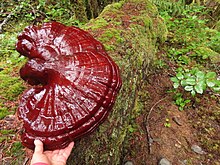| Ganoderma oregonense | |
|---|---|

| |
| Jefferson County, Washington, 2023 | |
| Scientific classification | |
| Domain: | Eukaryota |
| Kingdom: | Fungi |
| Division: | Basidiomycota |
| Class: | Agaricomycetes |
| Order: | Polyporales |
| Family: | Ganodermataceae |
| Genus: | Ganoderma |
| Species: | G. oregonense
|
| Binomial name | |
| Ganoderma oregonense | |
Ganoderma oregonense (also known as the west-coast reishi, western varnished conk, lacquer fungus, and/or American ling-chi) is a species of bracket fungus that causes root and butt white rot in conifers in northwestern coastal North America,[2][3] including California, Oregon, Washington, British Columbia, Yukon, and Alaska.[4] G. oregonense is very similar to Ganoderma tsugae,[5] but G. tsugae is associated with east coast Tsuga (hemlock) rather than west coast conifer.[6] Its been speculated that G. oregonense and G. tsugae might actually be one species, but mycologists just don't know for sure yet.[5]
Western varnished conk has a shiny brown-red-orange and sometimes cream-colored upper surface (often appearing as a color gradient), and white- or cream-colored pores.[3] It can be shaped like a kidney or a fan or a hoof,[7] or like a plate or stack of plates jammed into the side of a log. It fruits annually (rather than perennially), and usually shows up in the fall.[3] They can get quite big, up to a foot in size.[3]
Trees inoculated with G. oregonense end up with spongy, soft insides.[3] It prefers dead red fir but will also accept dead or alive Douglas fir, spruce, hemlock, and pine.[3] When this reishi is found on living trees it is usually consequent to tree wounds,[3] such as bear marks.
According to Paul Stamets, this fungus is edible.[8] This is unusual for a Ganoderma, specimens of which are usually far too tough to be eaten (reishi is often dried, powdered and consumed as a mushroom tea).[8]
This species was originally described by W. A. Murrill as "Pileus reniform, corky, rigid, convex above, plane below, 10 x 17 x 5 cm; surface glabrous, thinly encrusted, smooth, laccate, very lustrous, bay to black, with a deep groove near the margin, which is cream-colored, rounded, smooth, entire, finely tomentose; context punky, white to slightly discolored, homogeneous, with white lines of mycelium near the stipe, 2-3.5 cm. thick; tubes annual, 1 cm. long, avellaneous within, mouths circular to angular, 3 to a mm., edges thin, entire, white to avellaneous; stipe lateral, very thick, short, subcylindric, 2-4 cm long, 3-6 cm. thick, expanding into the pileus, which it resembles in color, surface, and context."[9]
References[edit]
- ^ "Ganoderma oregonense". indexfungorum.org.
- ^ Kuo, M. (January 2019). "Ganoderma oregonense". MushroomExpert.Com.
- ^ a b c d e f g Scharpf, Robert F. (1993). Diseases of Pacific Coast Conifers. U.S. Department of Agriculture, Forest Service. pp. 152, 174–177. ISBN 978-0-16-041765-8.
- ^ "Observations". iNaturalist. Retrieved 2024-02-03.
- ^ a b Trudell, Steve; Ammirati, Joe (2009). Mushrooms of the Pacific Northwest. Timber Press. p. 259. ISBN 978-1-60469-141-2.
- ^ Starwood, Jess (2021-08-17). Mushroom Wanderland: A Forager's Guide to Finding, Identifying, and Using More Than 25 Wild Fungi. The Countryman Press. pp. no pag. ISBN 978-1-68268-635-5.
- ^ Davis, R. Michael; Sommer, Robert; Menge, John A. (2012). Field Guide to Mushrooms of Western North America. University of California Press. p. 345. ISBN 978-0-520-27108-1.
- ^ a b "Cooking Ganoderma oregonense". Paul Stamets. 2020-09-11. Retrieved 2024-02-03.
- ^ Murrill, W. A. (1915). "Western Polypores". New York: self-published. p. 30. hdl:2027/mdp.39015069534363. Retrieved 2024-02-03 – via HathiTrust.